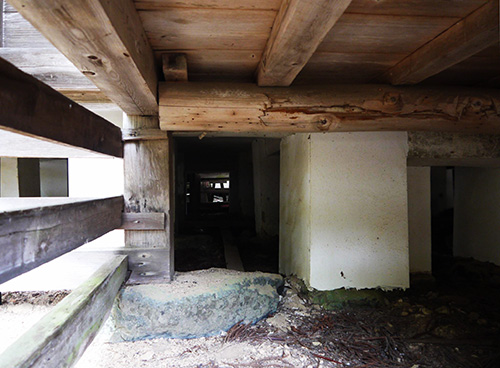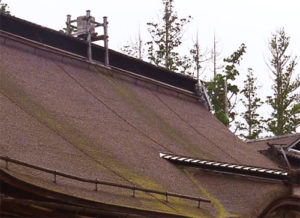



さて特報弊社企業ニュースで1日中断しましたが、ふたたび金剛峯寺探訪復帰。
高野山というのは空海による大規模開発によって宗教都市が開かれた。
ときの権力機構からの巨大な支援があっただろうけれど、
それにしても宗教的な修行を目的とした建築と都市空間であり、
原始の森が広がっていた地域であるのに違いはなかっただろう。
鬱蒼とした太古由来の森林からは巨木も伐採利用されたに違いない。
その創建時の建築苦闘を伝えるかのように、高野杉の断面標本が展示される。
なんですが金剛峯寺参観はすっかり観光化していて、
高野杉の割れ目に「コインを挟まないで」という添え書きまでされている。
ローマの泉へのコイン投げ入れとは反対の意味で観光化を表している。
まぁ、偽らざる衆生の反応といえるのでしょうか。
それはやむを得ないとしてしかしこの杉の巨径には率直に驚く。
数百年・千年レベルの大径木が鬱蒼と繁茂していただろう様子を想像できる。
たぶん一種の国家事業、公共事業として取り組まれて
平安初期の時代の最先端建築技術者たちが人材投入されたに違いない。
数度に及ぶ火災で建て替えられていて、現在の主屋は江戸期のものとされる。
その構造表現は内部ではあらわしのカタチでは見られないけれど、
床下空間を覗ける箇所があったので撮影してみた次第。
材の特定まではわかりませんでしたが、床組みの材の丸太など特徴的。
束石のほかにコンクリート基礎補修の状況も見て取れる。
一方で屋根材は檜皮葺きということで、
こちらは原料の檜皮がハコに入れられて鑑賞に供されている。
主屋建築の巨大さを考えてより軽量な素材が選択されたものと思えます。
創建当時、この高野山一帯でさかんに用材の伐採が行われ、また、
檜皮がヒノキの本体からそぎ落とされるプロセスが一気に集中的に施工された。
ちょうど北海道の開拓初期・明治初年の札幌開府のような
そういった建築営為だったのではないかと想像が膨らんできます。
こういった仏教寺院建築が統一国家日本の創成期以来、
なんども押し寄せる波のように社会に波及していったという事実。
権力機構が持っただろう建築群は生々流転を繰り返したけれど、
こうした宗教建築は息長く存続してきた。人間社会のありように面白みを感じる。
最近のNHK歴史番組「英雄たちの選択」では日本列島の「こころの歴史」みたいな
視点が語られるようになって来ている。
考古の世界の縄文以来の土偶・埴輪などの「顔の表現」からあきらかになってくる
日本人の「こころ」を歴史研究の一領域に位置づけつつあるのだというのです。
世界有数の発掘密度で進む考古・歴史の研究から
人類最先端の歴史研究領域が日本によって開拓されつつあるのだと。
そういった一端に建築探訪もまた位置づけがあり得ると思っております。
English version⬇
[Explanatory exhibition of structure and roofing materials Koyasan / Kongobuji-7]
By the way, although it was interrupted for one day due to our company news, we returned to Kongobuji Temple.
Koyasan was opened as a religious city by the large-scale development by Kukai.
There would have been huge support from the power organization at that time,
Even so, it is an architecture and urban space aimed at religious training,
There must have been no difference in the area where the pristine forest was widespread.
Giant trees must have been cut down from the dense ancient forests.
A cross-sectional specimen of Takano Sugi will be exhibited as if to convey the architectural struggle at the time of its construction.
However, the visit to Kongobuji Temple has become a tourist attraction.
There is even an appendix saying “Don’t pinch coins” in the cracks of Takano Sugi.
It represents tourism in the opposite sense of throwing coins into the Roman fountain.
Well, is it a true reaction of sentient beings?
But as it is unavoidable, I am frankly surprised by the huge diameter of this cedar.
I can imagine how large-diameter trees of hundreds or thousands of years would have grown densely.
Probably a kind of national project, being tackled as a public project
The cutting-edge construction engineers of the early Heian period must have been put in.
It has been rebuilt by several fires, and the current main building is said to be from the Edo period.
The structural expression cannot be seen internally in the form of representation,
There was a place where I could look into the underfloor space, so I took a picture.
I did not know until the material was specified, but it is characteristic such as the log of the floor lumber.
In addition to the boulders, the situation of concrete foundation repair can also be seen.
On the other hand, the roofing material is cypress-roofed, so
Here, the raw material cypress bark is put in a box and used for appreciation.
It seems that a lighter material was selected considering the huge size of the main building.
At the time of its construction, lumber was actively cut down in the Koyasan area, and
The process of removing the cypress skin from the body of the cypress was carried out intensively at once.
Just like the opening of Sapporo in the early days of the development of Hokkaido and the first year of the Meiji era
I can imagine that it was such an architectural project.
Since the founding of Japan, a unified nation of Buddhist temple architecture,
The fact that it spread to society like a wave of waves.
The group of buildings that the power organization would have had repeated the flow of life, but
Such religious architecture has survived for a long time. I feel the fun of human society.
In the recent NHK history program “Decision of the Heroes”, it looks like “History of the heart” of the Japanese archipelago.
Perspectives are being talked about.
It becomes clear from the “expression of the face” such as clay figurines and haniwa since the Jomon period in the archaeological world.
It is said that the Japanese “heart” is being positioned as an area of historical research.
From archaeological and historical research that progresses with the world’s highest excavation density
Japan is pioneering the most advanced historical research area of humankind.
I think that architectural exploration can also be positioned at one end.
Posted on 11月 1st, 2021 by 三木 奎吾
Filed under: 住宅マーケティング, 日本社会・文化研究, 歴史探訪







コメントを投稿
「※誹謗中傷や、悪意のある書き込み、営利目的などのコメントを防ぐために、投稿された全てのコメントは一時的に保留されますのでご了承ください。」
You must be logged in to post a comment.